Online
- Provide feedback via the online survey
The Alexandrina 25km coastline has significant cultural, social, environmental, and economic value to our local community, the Ngarrindjeri Nation and visitors to the region. Rising sea levels will exacerbate erosion and seawater inundation in many coastal areas.
Horseshoe Bay in Port Elliot is one beach identified as a priority action area in our 2022 Coastal Adaptation Plan
Recent investigations indicate the shoreline will recede by up to 12m by 2050 and 25m by 2100, placing built infrastructure at risk.
An independent coastal engineer appointed by Council has investigated the projected impacts of coastal hazards such as sea level rise and coastal erosion in the Bay.
Options for mitigation have been identified, along with their associated trade-offs, including effectiveness, cost, risk, and environmental impacts. These options include:Cape Advisory has also provided initial estimates of possible capital and operational costs for four of the options.
We sought community feedback on these presented options.
Council has not formed a view regarding the options and is consulting with key stakeholders and the community to understand their views.
The area of Horseshoe Bay that houses built infrastructure is Crown Land under Council Care and Control. The State Government's Coast Protection Board has ‘power of direction’ over this area and will have the final say.
You can prepare your own written submissions, or download a hardcopy survey from the Document Library.
Visit the Goolwa or Strathalbyn Council Office to:
Option 1 – Raise existing breakwater height and length

Capital cost: $17.9M
30-year operating cost: $0.6M
*None of the options are presented in order of preference or priority.
Option 2 – Offshore underwater breakwater in the nearshore
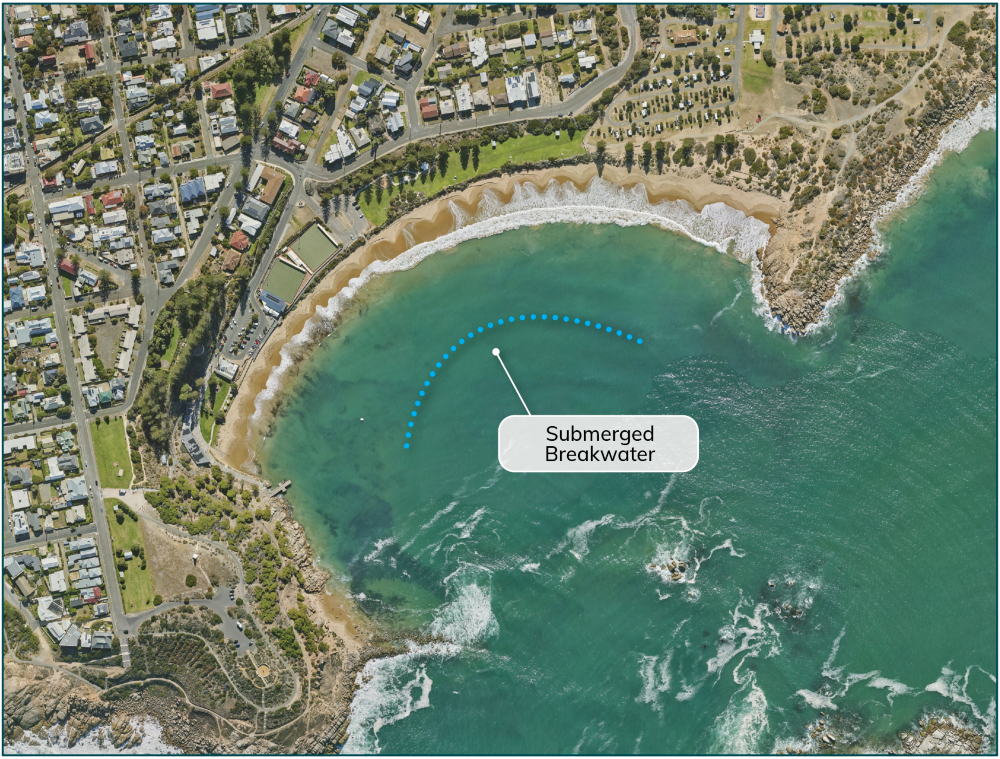
Capital cost: $9.3M
30-year operating cost: $0.3M
*None of the options are presented in order of preference or priority.
Option 3A – Sand nourishment (bay sand)
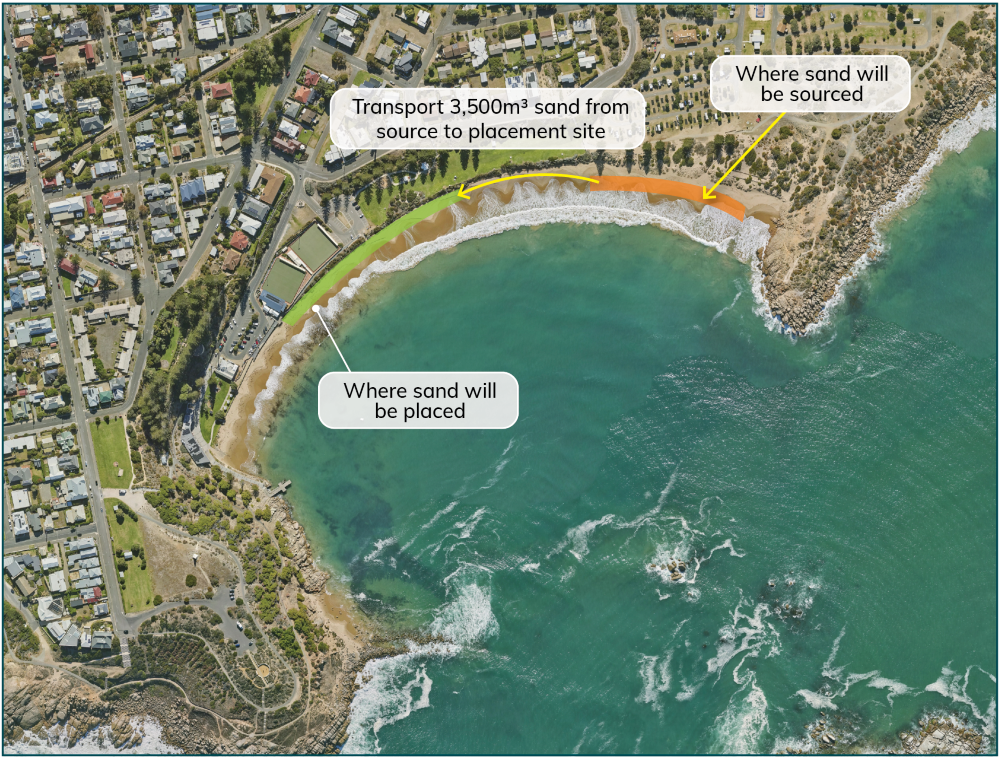
This option intends to increase the volume of sand in the central part of the Bay by borrowing sand from the eastern part of the Bay (beach, not dunes, in the short term) to increase capacity for erosion during storms. In this case, the beach profile on the eastern side of the bay would retreat by 10m to provide the source of sand.
Consultants advised that this option is effective in the short term and moderately effective in the long term.
Capital cost: $0M
30-year operating cost: $0.35M-$1.5M ongoing every 1-5 years, depending on seasonal weather impacts.
*None of the options are presented in order of preference or priority.
Option 3B – Sand nourishment (quarry sand)
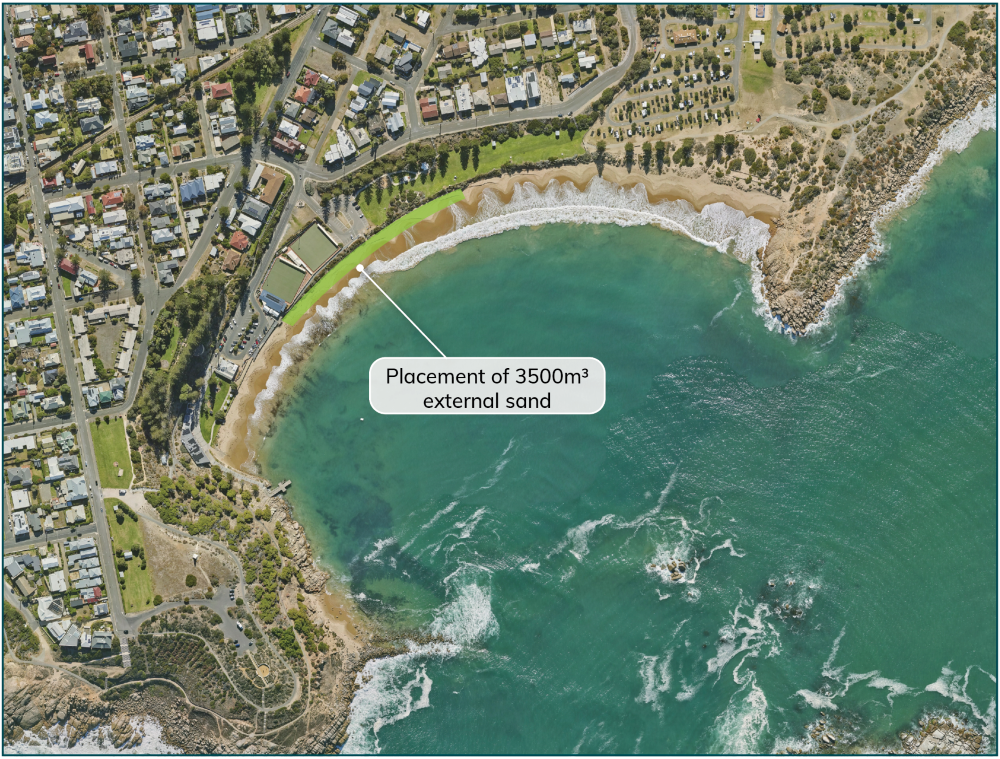
Capital cost: $0M
30-year operating cost: $1.25M-$5.4M (every 1-5 years, depending on seasonal weather impacts)
Pros
Cons
*None of the options are presented in order of preference or priority.
Option 4A – Buried seawall & existing seawall replacement
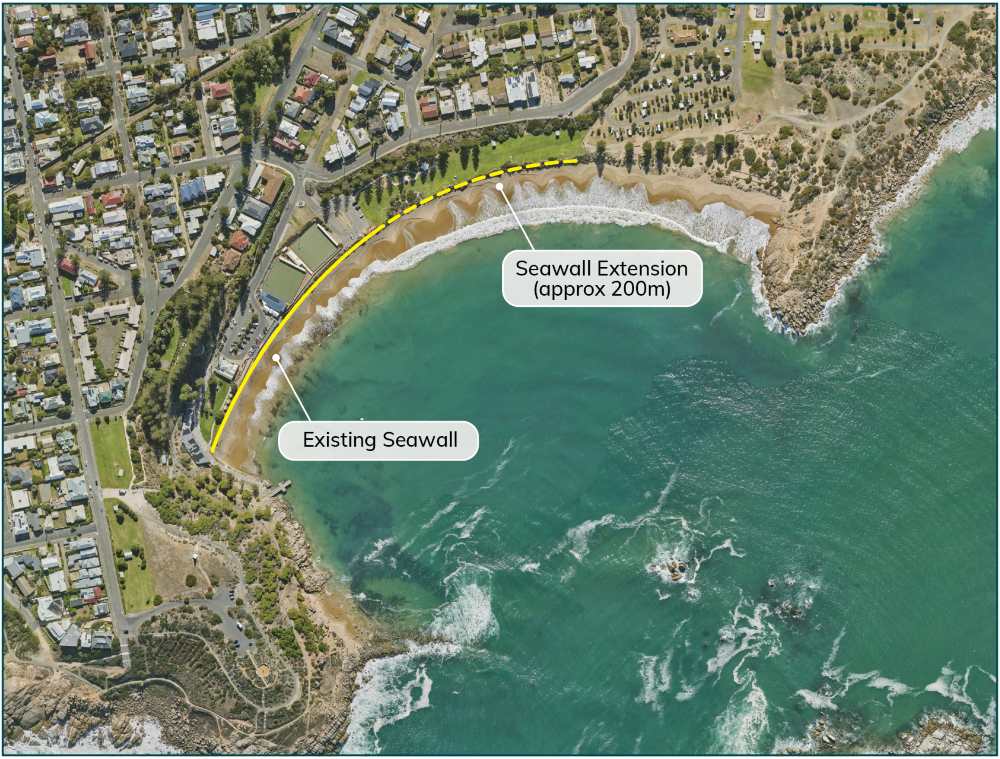
This option intends to ‘hold the line’ against beach erosion by extending the vertical seawall. This will remove the risk to built infrastructure. However, the beach in front of the wall will continue to erode/deepen and reduce the amount of usable beach over time. Consultants advise this option would be effective in the short term and in the longer term.
Capital cost: $3.6M
30-year operating cost: $0.2M
*None of the options are presented in order of preference or priority.
Option 4B - Buried seawall and existing seawall replacement with nourishment
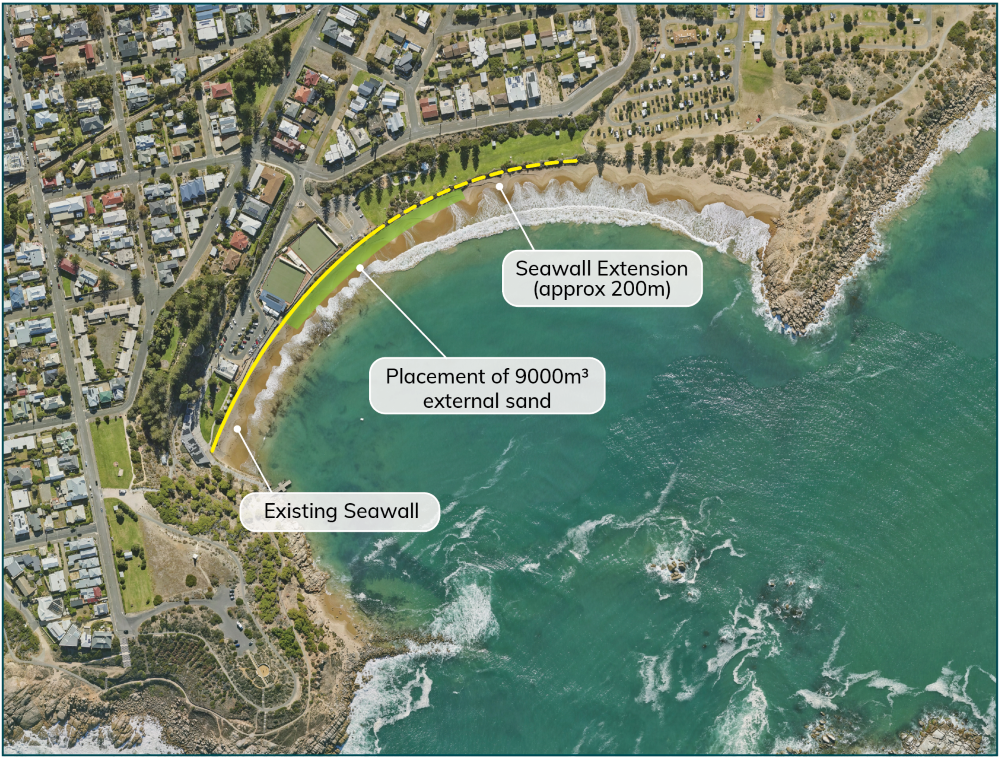
This option intends to ‘hold the line’ against beach erosion by extending the vertical seawall but also bringing in approximately 9000m3 of external sand to better maintain a useable sandy beach.
Consultants advised that this option would be effective in the short term and the longer term.
Capital cost: $3.6M
30-year operating cost: $1M-$4M
*None of the options are presented in order of preference or priority.
Option 5 – Managed relocation of assets
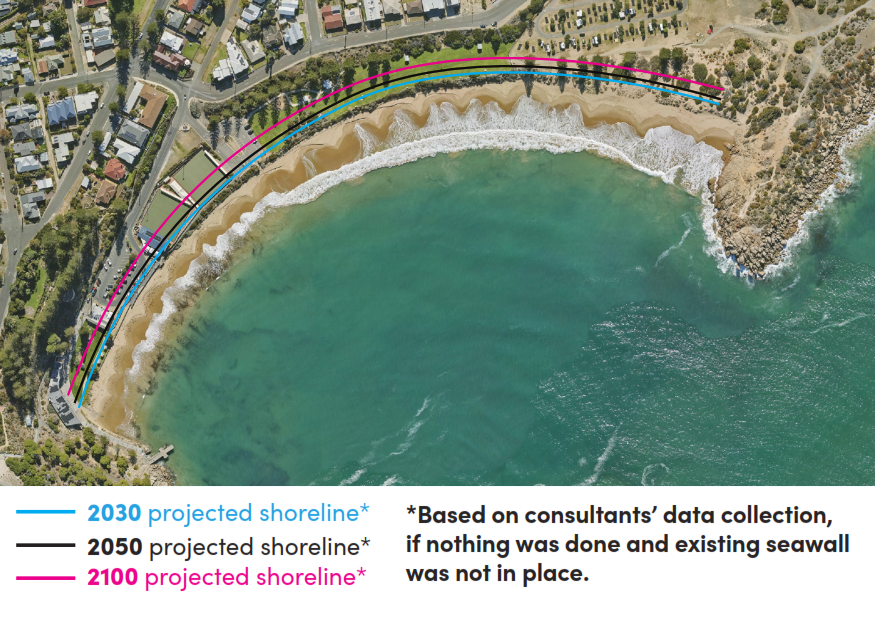
This option would seek to progressively move buildings and assets out of the areas were shoreline recession is anticipated. This would need to be done collaboratively with asset users. Due to complexities of this option, it was not costed or assessed in detail by the consultant.
Consultant advises that this option would be effective in the short term and the longer term.
Due to the complexities of this option, it was not costed or assessed in detail by the consultant.
*None of the options are presented in order of preference or priority.
| Phone | (08) 8555 7000 |
|---|---|
| alex@alexandrina.sa.gov.au | |
| Website | www.alexandrina.sa.gov.au |
This site (My Say Alexandrina) is owned and operated by Alexandrina Council using software licensed from Social Pinpoint. For details of how Social Pinpoint may access personal information, please refer to Social Pinpoint’s Privacy Policy.
Collection and Use of Personal Information
Alexandrina Council collects personal information and responses submitted through the My Say Alexandrina platform for the purpose of community consultation and engagement. This information may include but not limited to:
Reports generated from the My Say platform and received via post or email are allocated and reviewed by the relevant project officer.
Email contact may be made via the email address provided within a submission regarding an update to the relevant project.
Reporting and Disclosure
Reports published on the My Say Alexandrina project page (‘Community Engagement Report) and presented at Council Meetings will summarise general themes and feedback received. These reports:
Privacy Commitment
Alexandrina Council is committed to protecting your privacy in accordance with its Privacy Policy and relevant legislation. Personal information will only be used for the purpose for which it was collected and will not be disclosed without consent, unless required by law.
The following Terms and Conditions govern the use of My Say Alexandrina (“the site”). The software platform is owned by Social Pinpoint Pty Ltd and operated by us, Alexandrina Council.
By accessing and using this site, you are choosing to accept and comply with the Terms presented throughout this agreement as well as the Privacy Policy and Social Pinpoint’s Moderation Policy, further information on our Moderation page. These Terms apply to all visitors and users of this site. Linked sites, affiliated services or third party content or software have their own Terms that you must comply with. If you disagree with any of the Terms presented in this agreement, you may discontinue using the site immediately.
If you are under 18 years old, please ensure that your parent or guardian understands and accepts these Terms of Use (including the Privacy Policy and Moderation Policy).
What are the conditions with a user’s account?
While using the site, you must not violate any applicable laws and regulations. It is our duty to protect the confidentiality of content you provide on our site in accordance with our Privacy Policy. When you create an account with us, you must always provide us with accurate information. Failure to provide accurate information violates the Terms, which may result in immediate termination of your account on our service. You are responsible for protecting your own password you use for this site and for any activities done under that password. Unauthorised use of your password or account must be immediately reported to us. In some cases, we or our agents may require access to your user accounts to respond to technical issues.
We are not responsible for the content on the site that has been provided by the users of the site. Any content posted by you is subject to the rules of our Moderation Policy. Your contribution to the site may be edited, removed or not published if we consider it inappropriate (refer to Moderation Policy). Contributors should also be aware that their posts may remain online indefinitely. Where practical, you may choose not to identify yourself, deal with us on an anonymous basis or use a pseudonym.
What do we require from our users?
You must understand and agree that, without limitation:
Can your account be suspended or terminated?
We may terminate or suspend access to your site and/or account immediately, without prior notice, including without limitation if you breach the Terms. We may immediately deactivate or delete your account and all the related files and information in your account. After your account has been terminated, the content you have posted may also remain indefinitely on the site.
If you want to terminate your own account, please send an email to engagement@alexandrina.sa.gov.au
Governing Law
These Terms shall be governed in accordance with the laws of South Australia, Australia. Our failure to enforce any right or provision of these Terms will not be considered a waiver of those rights. If any provision of these Terms is held to be invalid or unenforceable by a court, the remaining provisions of these Terms will remain in effect.
Indemnification
Alexandrina Council, its subsidiaries, affiliates, officers, agents, licensors and other partners are not responsible for any loss, liability, claim, or demand, including legal fees, made by any third party due to or arising from a breach of this agreement and/or any breach of your representations and warranties set forth above.
What content do we own?
This website contains the copyrighted material, trademarks, patents, trade secrets and other proprietary information (“Intellectual Property”) of Alexandrina Council and its suppliers and licensors. Alexandrina Council owns and retains all proprietary rights in the intellectual property. All intellectual property in the content of this site including without limitation to text, software, source code, pages, documents and online graphics, photographs, sounds, audio, video and other interactive features are owned by or licensed to us.
Any original content that you submit or post on our site may be made available to the public and allows users to share your content (with the end user acknowledging your contribution) under the Creative Commons Attribution-ShareAlike 4.0 Australian License.
Except for Intellectual Property which is in the public domain or for which you have been given written permission, you may not copy, alter, transmit, sell, distribute any of the Intellectual Property on this site.
We are not responsible for your communications or dealings, including payment and delivery of goods or services, with a third party found via our website. Any loss or damage incurred from those communications or dealings are solely between the user and the third party.
Disclaimer and Warranties
Users must agree that you use of the site is at your own risk. We make no warranty that the site will meet your requirements or be uninterrupted or error-free. Any material that the user downloads through the site is done at their own risk and are responsible for any damages to their computer system or loss of data.
What happens if these Terms change?
We reserve the right, at our sole discretion, to modify or replace these Terms at any time without notice. The most recent version of the Terms can be seen on this page. By continuing to access or use our site after those revisions become effective, you agree and will comply to the revised terms. If you do not agree to the revised terms, please discontinue using our site.
Contact Us
If you have any questions about these Terms, please contact us at engagement@alexandrina.sa.gov.au
Enter your email address below. We will send you instructions to reset your password.
Back to Log in
By creating an account, you’ll automatically be subscribed to our My Say Alexandrina e-newsletter. These are sent when new consultations go live (no more than once a week), and you can unsubscribe at any time.
Already have an account? Log in now
Thank you, your account has been created.
Completing the questions below helps us better understand the diverse range of people who contribute their ideas. The questions are optional.
You’re using an outdated browser.
Some features of this website may not work correctly. To get a better experience we strongly recommend you download a new browser for free:
Would you like to follow this project to receive email updates?